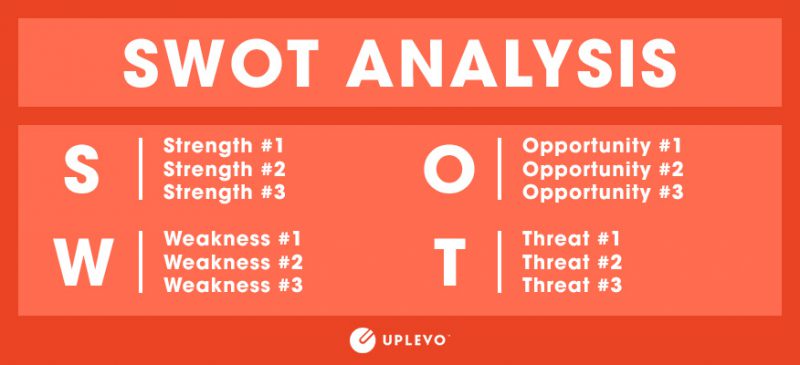
Not only in marketing in particular, but also in business in general, SWOT analysis is a tool that is both effective and simple to set up a business’s strategy, helping them to build and develop their own path. long-term behavior.
So what is SWOT?
SWOT is a term that represents Strengths (strengths), Weaknesses (weaknesses), Opportunities (opportunities) and Threats (threats).
Strengths and Weaknesses represent the internal factors of the business. These are two factors you can control and change. Often these factors are related to company operations, corporate assets, product development, etc.
Opportunities and Threats are external factors, often related to the market and of a macro nature. Enterprises can fully seize opportunities, but must also pay attention and watch out for external challenges that may come. Given these factors, businesses are often unable to control and change, such as competitor issues, input material prices, customer shopping trends, and much more.
A SWOT analysis can help you highlight your strengths, identify weaknesses you need to overcome, seize external opportunities, and prevent challenges that lie ahead. Usually, a SWOT analysis table will be presented in the form of two rows and two columns, as the example illustrated below.

When you take the time to do a SWOT analysis, your business will surely create the necessary strategies and recommendations when combining the SWO and T factors together. Those are the foundations that the company needs to develop its future direction.
You think your business already has everything it needs to be successful and stand out, but did you know that SWOT can bring new perspectives, and great strategies? that you yourself may not even realize?
Why do we have to do a SWOT analysis?
To make a really useful SWOT analysis, often the founders and senior leaders in a business will be directly involved in the process of building them. This is clearly not a job that can be delegated to anyone else.
But sometimes, the senior leadership team is not directly involved in many activities of the business. Therefore, to achieve the highest efficiency, the SWOT strategy needs to have the contribution of a group of members representing many different departments and divisions. Everyone should have a seat on the team that develops the SWOT analysis.
Large enterprises go even further, when they collect information directly from customers for SWOT analysis. You can completely consult your friends, the accounting department, or even your raw material suppliers and product suppliers.
Different perspectives can be of great help in formulating and formulating a specific business strategy.
Businesses can completely use the SWOT model to assess the current situation, and to come up with next strategies for themselves. But you should remember, every step of change needs to be unified. If you want to review and evaluate the effectiveness of your new strategy, you can do a SWOT analysis in the next 6-12 months.
For small businesses (like start-ups), SWOT acts as a blueprint that outlines the steps in the formation and development of a business. It’s really helpful in determining what steps they should take in their arduous journey ahead.
>>> A Comprehensive Guide to Online Marketing
How to build an effective SWOT analysis
The first thing you need to do here, is to gather a group of people from many different departments in the business to build a SWOT model. It is not necessary to spend all day brainstroming, just one to two hours is enough for this job.
Consulting with people with different expertise will make your SWOT analysis really valuable.
As mentioned above, doing a SWOT is no different from a brainstorming meeting. Everyone should write down their own ideas on paper. This helps prevent everyone from focusing too much on a particular idea, and ensures everyone’s opinions are heard.

After 5 to 10 personal ideas, all stick their own sticky notes on the wall and group the ideas together. You should allow people to add new ideas on top of old ideas. This helps to generate unique perspectives with a whole new perspective.
After grouping the ideas together, it’s time to rank them. You can completely use the popular vote method to determine which ideas are most important and necessary. Of course, this can raise some minor arguments.
>>> Learn the basics of Marketing: Marketing Mix ; Marketing Model 4Cs
Essential questions in SWOT analysis
Here are a few questions to keep in mind when developing a SWOT strategy:
 Strengths – Strengths:
Strengths – Strengths:
The strength of a business is often internal factors that can help the business grow and build its advantage over competitors in the market. These factors can be controlled by the enterprise.
- What processes are businesses adopting that can help them become successful?
- What human strengths does your business have, such as professional skills, relationships, education, job skills, reputation,…?
- What are the physical strengths and assets that the business owns, such as customer files, facilities, finance, technology, patents,…?
- What competitive advantage does the business have compared to competitors in the market?
 Weaknesses – Weaknesses:
Weaknesses – Weaknesses:
Weaknesses are the unfavorable factors that your business is having. You need to overcome these weaknesses yourself, if you want to compete with competitors in the market.
- What points do businesses need to overcome to compete better?
- What process does the business need to improve?
- What assets does the business need to supplement, such as money or equipment?
- What gaps exist that need to be filled in about the people working in your business?
- Is the location / headquarters where your business is operating suitable for future development?
 Opportunities – Opportunity:
Opportunities – Opportunity:
The main opportunities are the external environmental factors that can greatly help the success of your business in the future.
- Is your business’ focus market growing? Is there an existing trend for customers to consume the product you are offering in the future?
- Are there any upcoming events that your business can capture to grow?
- Is there a change that could have a positive impact on your business?
- As it grows, will customers appreciate your business?
 Threats – Challenges:
Threats – Challenges:
Challenges are external factors that can adversely affect the operation of your business. Often these factors you cannot control, you can only predict and devise strategies to deal with them.
- Do you have to deal with potential competitors later?
- Will the supplier supply the raw materials to the business at a reasonable price that you can accept?
- Is the development of technology bad for your business?
- Is the change in customer behavior a concern for your business?
- Will the future market trend be a challenge for businesses in the future?
Visual example of SWOT analysis
To give you a more intuitive view of the SWOT model, we introduce you to an analysis from Upper Crust Pies , a company specializing in providing pastry products in Michigan, USA. The chain’s products include pastries, salads, and drinks.
The company is planning to open a store in Yubetchatown and is looking forward to developing a chain of stores in a short time. Here is their own SWOT analysis:
Strength:
- Location: Busy residential area.
- Unique point: Different from fast food chains.
- Management team: All are people with wide expertise.
Weakness:
- Lack of capital: Only borrowed capital and other investors.
- Lack of credibility: This is the first store in the area.
Opportunity:
- Growth prospects: The Yubetchatown market grows 8.5% per year.
- Prospects from the target audience: More and more families with salaried parents are in the market.
Challenge:
- Competition: Many other stores have loyal customers.
- The problem of “post-opening”: Guests may not return to dine at the restaurant after the opening.
What to do next?
After completing the SWOT analysis, you need to turn the theories on paper into reality. Obviously, this is a matter of how you can build and recommend strategies that are really useful over the next few months.
As a first step, you need to pair the elements of the SWOT, such as connecting strengths and opportunities, to see how your business can use its advantages to seize opportunities in the market.
Then use existing strengths to deal with future challenges the business may face. You can use this analysis to establish the necessary strategies.

With your to-do list in hand, you need to consider the timing and set goals for these strategies. How effectively do you need to achieve each month/quarter?
Besides, your business is also very interested in what opportunities out there can help you fill in the existing weaknesses in you. Or, what weaknesses can you overcome to face the coming external challenge? Similarly, you link the elements together in the SWOT and come up with specific strategies only.
Going back to the Upper Crust Pies example, here are the strategies they came up with after linking the elements in their SWOT analysis:
Strategy for the future growth of Upper Crust Pies:
Looking for new investors.
Create a marketing plan: Since the company needs to attract the attention of customers who are working-class families, need a really comfortable and healthy meal, businesses need to develop a strategy appropriate marketing.
Planning for the opening ceremony: Since businesses need to keep their target customers after the opening ceremony, Uper needs to carefully plan this ceremony (such as implementing communication policies, promotions, etc.) ).
>>> 2 Basic Business Models: B2B and B2C
Ending
Hopefully the above sharing can be of great help to you in building a reasonable SWOT analysis, helping to establish and develop long-term strategies later for your business.




